HRM Challenges in Manufacturing: Attracting and Retaining Staff - CQU
VerifiedAdded on 2023/06/11
|11
|3748
|476
Essay
AI Summary
This essay delves into the significant Human Resource Management (HRM) challenges faced by the manufacturing industry in attracting and retaining employees. It identifies issues such as a lack of strategic HR planning, unattractive work environments, poor communication between HR and employees, limited diversity, insufficient skills, repetitive job tasks, job insecurity, and inadequate compensation. Furthermore, the essay addresses retention issues stemming from ineffective company policies, exhausting work conditions, lack of career growth, and poor work-life balance. To mitigate these challenges, the essay recommends that manufacturing industries implement better HR policies, foster a positive work environment, improve communication, offer competitive compensation, and appreciate employee contributions. The goal is to create a more engaging and supportive workplace that attracts and retains skilled employees, ultimately improving productivity and reducing employee turnover.
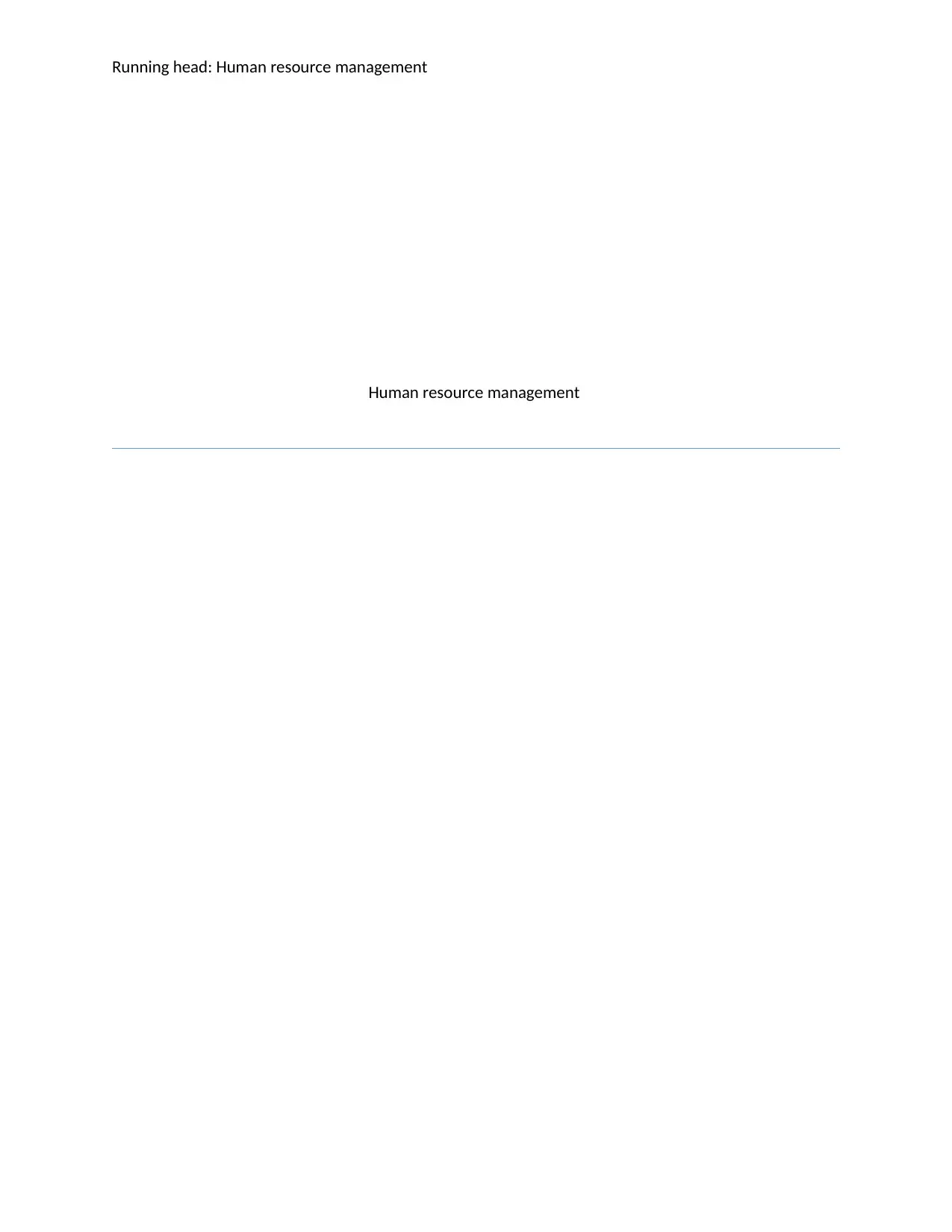
Running head: Human resource management
Human resource management
Human resource management
Paraphrase This Document
Need a fresh take? Get an instant paraphrase of this document with our AI Paraphraser
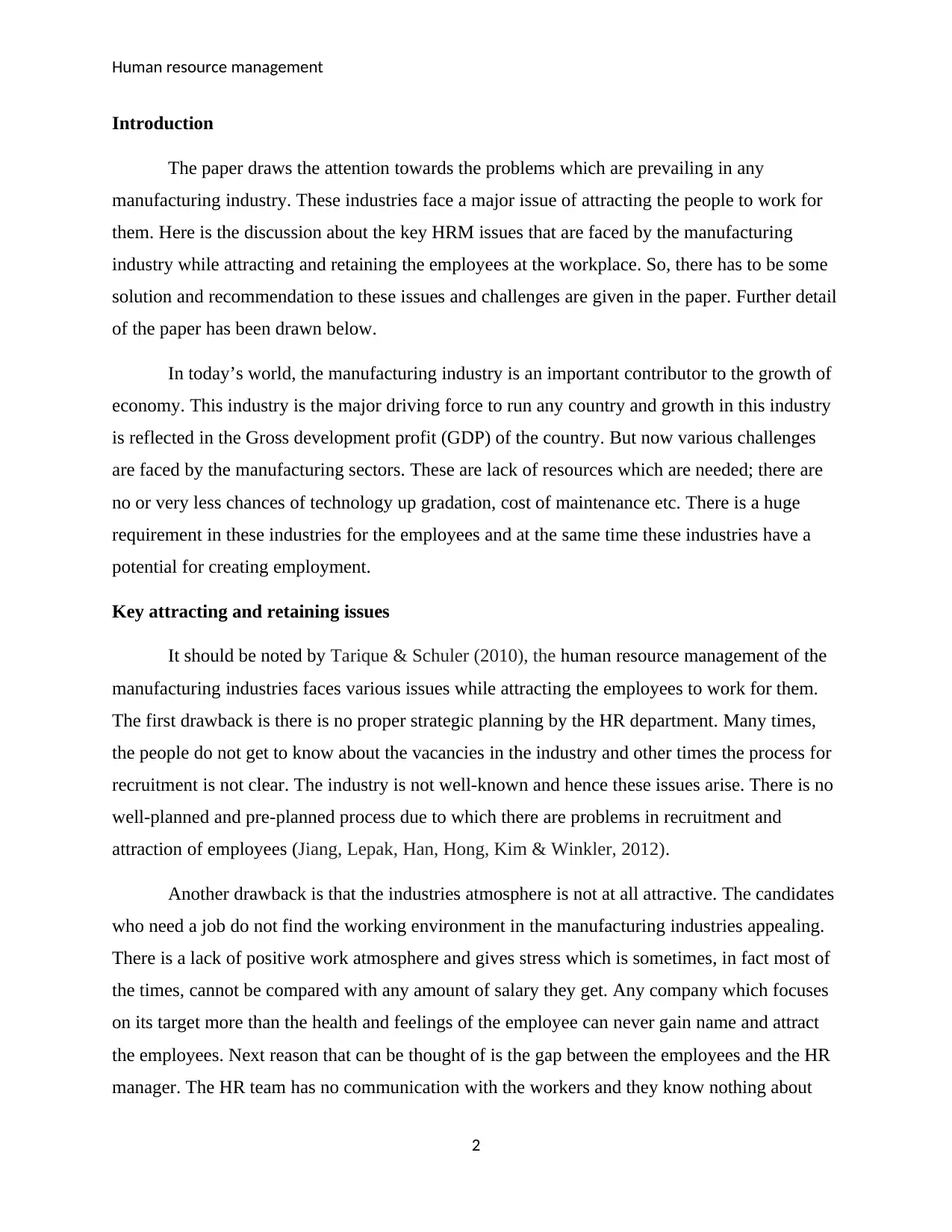
Human resource management
Introduction
The paper draws the attention towards the problems which are prevailing in any
manufacturing industry. These industries face a major issue of attracting the people to work for
them. Here is the discussion about the key HRM issues that are faced by the manufacturing
industry while attracting and retaining the employees at the workplace. So, there has to be some
solution and recommendation to these issues and challenges are given in the paper. Further detail
of the paper has been drawn below.
In today’s world, the manufacturing industry is an important contributor to the growth of
economy. This industry is the major driving force to run any country and growth in this industry
is reflected in the Gross development profit (GDP) of the country. But now various challenges
are faced by the manufacturing sectors. These are lack of resources which are needed; there are
no or very less chances of technology up gradation, cost of maintenance etc. There is a huge
requirement in these industries for the employees and at the same time these industries have a
potential for creating employment.
Key attracting and retaining issues
It should be noted by Tarique & Schuler (2010), the human resource management of the
manufacturing industries faces various issues while attracting the employees to work for them.
The first drawback is there is no proper strategic planning by the HR department. Many times,
the people do not get to know about the vacancies in the industry and other times the process for
recruitment is not clear. The industry is not well-known and hence these issues arise. There is no
well-planned and pre-planned process due to which there are problems in recruitment and
attraction of employees (Jiang, Lepak, Han, Hong, Kim & Winkler, 2012).
Another drawback is that the industries atmosphere is not at all attractive. The candidates
who need a job do not find the working environment in the manufacturing industries appealing.
There is a lack of positive work atmosphere and gives stress which is sometimes, in fact most of
the times, cannot be compared with any amount of salary they get. Any company which focuses
on its target more than the health and feelings of the employee can never gain name and attract
the employees. Next reason that can be thought of is the gap between the employees and the HR
manager. The HR team has no communication with the workers and they know nothing about
2
Introduction
The paper draws the attention towards the problems which are prevailing in any
manufacturing industry. These industries face a major issue of attracting the people to work for
them. Here is the discussion about the key HRM issues that are faced by the manufacturing
industry while attracting and retaining the employees at the workplace. So, there has to be some
solution and recommendation to these issues and challenges are given in the paper. Further detail
of the paper has been drawn below.
In today’s world, the manufacturing industry is an important contributor to the growth of
economy. This industry is the major driving force to run any country and growth in this industry
is reflected in the Gross development profit (GDP) of the country. But now various challenges
are faced by the manufacturing sectors. These are lack of resources which are needed; there are
no or very less chances of technology up gradation, cost of maintenance etc. There is a huge
requirement in these industries for the employees and at the same time these industries have a
potential for creating employment.
Key attracting and retaining issues
It should be noted by Tarique & Schuler (2010), the human resource management of the
manufacturing industries faces various issues while attracting the employees to work for them.
The first drawback is there is no proper strategic planning by the HR department. Many times,
the people do not get to know about the vacancies in the industry and other times the process for
recruitment is not clear. The industry is not well-known and hence these issues arise. There is no
well-planned and pre-planned process due to which there are problems in recruitment and
attraction of employees (Jiang, Lepak, Han, Hong, Kim & Winkler, 2012).
Another drawback is that the industries atmosphere is not at all attractive. The candidates
who need a job do not find the working environment in the manufacturing industries appealing.
There is a lack of positive work atmosphere and gives stress which is sometimes, in fact most of
the times, cannot be compared with any amount of salary they get. Any company which focuses
on its target more than the health and feelings of the employee can never gain name and attract
the employees. Next reason that can be thought of is the gap between the employees and the HR
manager. The HR team has no communication with the workers and they know nothing about
2
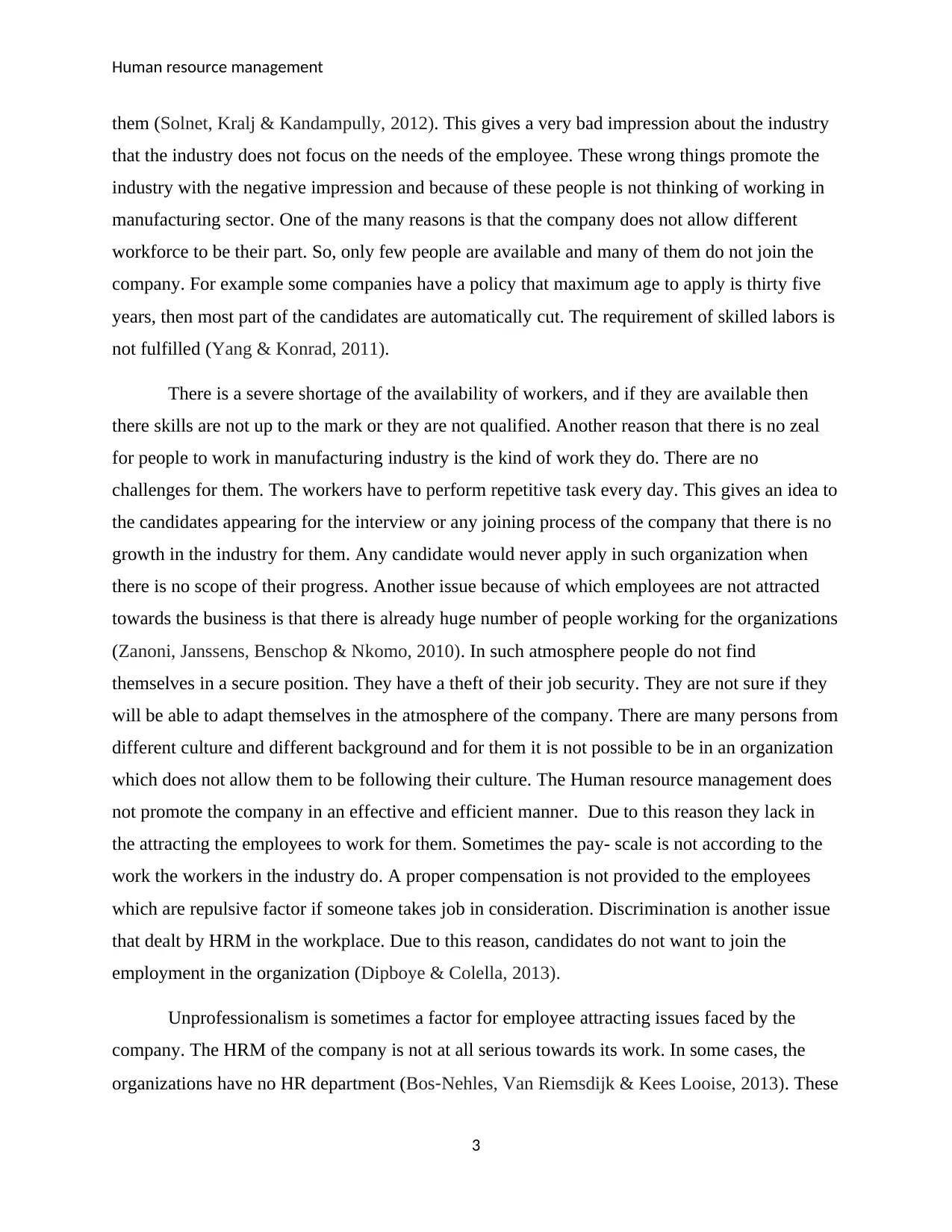
Human resource management
them (Solnet, Kralj & Kandampully, 2012). This gives a very bad impression about the industry
that the industry does not focus on the needs of the employee. These wrong things promote the
industry with the negative impression and because of these people is not thinking of working in
manufacturing sector. One of the many reasons is that the company does not allow different
workforce to be their part. So, only few people are available and many of them do not join the
company. For example some companies have a policy that maximum age to apply is thirty five
years, then most part of the candidates are automatically cut. The requirement of skilled labors is
not fulfilled (Yang & Konrad, 2011).
There is a severe shortage of the availability of workers, and if they are available then
there skills are not up to the mark or they are not qualified. Another reason that there is no zeal
for people to work in manufacturing industry is the kind of work they do. There are no
challenges for them. The workers have to perform repetitive task every day. This gives an idea to
the candidates appearing for the interview or any joining process of the company that there is no
growth in the industry for them. Any candidate would never apply in such organization when
there is no scope of their progress. Another issue because of which employees are not attracted
towards the business is that there is already huge number of people working for the organizations
(Zanoni, Janssens, Benschop & Nkomo, 2010). In such atmosphere people do not find
themselves in a secure position. They have a theft of their job security. They are not sure if they
will be able to adapt themselves in the atmosphere of the company. There are many persons from
different culture and different background and for them it is not possible to be in an organization
which does not allow them to be following their culture. The Human resource management does
not promote the company in an effective and efficient manner. Due to this reason they lack in
the attracting the employees to work for them. Sometimes the pay- scale is not according to the
work the workers in the industry do. A proper compensation is not provided to the employees
which are repulsive factor if someone takes job in consideration. Discrimination is another issue
that dealt by HRM in the workplace. Due to this reason, candidates do not want to join the
employment in the organization (Dipboye & Colella, 2013).
Unprofessionalism is sometimes a factor for employee attracting issues faced by the
company. The HRM of the company is not at all serious towards its work. In some cases, the
organizations have no HR department (Bos‐Nehles, Van Riemsdijk & Kees Looise, 2013). These
3
them (Solnet, Kralj & Kandampully, 2012). This gives a very bad impression about the industry
that the industry does not focus on the needs of the employee. These wrong things promote the
industry with the negative impression and because of these people is not thinking of working in
manufacturing sector. One of the many reasons is that the company does not allow different
workforce to be their part. So, only few people are available and many of them do not join the
company. For example some companies have a policy that maximum age to apply is thirty five
years, then most part of the candidates are automatically cut. The requirement of skilled labors is
not fulfilled (Yang & Konrad, 2011).
There is a severe shortage of the availability of workers, and if they are available then
there skills are not up to the mark or they are not qualified. Another reason that there is no zeal
for people to work in manufacturing industry is the kind of work they do. There are no
challenges for them. The workers have to perform repetitive task every day. This gives an idea to
the candidates appearing for the interview or any joining process of the company that there is no
growth in the industry for them. Any candidate would never apply in such organization when
there is no scope of their progress. Another issue because of which employees are not attracted
towards the business is that there is already huge number of people working for the organizations
(Zanoni, Janssens, Benschop & Nkomo, 2010). In such atmosphere people do not find
themselves in a secure position. They have a theft of their job security. They are not sure if they
will be able to adapt themselves in the atmosphere of the company. There are many persons from
different culture and different background and for them it is not possible to be in an organization
which does not allow them to be following their culture. The Human resource management does
not promote the company in an effective and efficient manner. Due to this reason they lack in
the attracting the employees to work for them. Sometimes the pay- scale is not according to the
work the workers in the industry do. A proper compensation is not provided to the employees
which are repulsive factor if someone takes job in consideration. Discrimination is another issue
that dealt by HRM in the workplace. Due to this reason, candidates do not want to join the
employment in the organization (Dipboye & Colella, 2013).
Unprofessionalism is sometimes a factor for employee attracting issues faced by the
company. The HRM of the company is not at all serious towards its work. In some cases, the
organizations have no HR department (Bos‐Nehles, Van Riemsdijk & Kees Looise, 2013). These
3
⊘ This is a preview!⊘
Do you want full access?
Subscribe today to unlock all pages.

Trusted by 1+ million students worldwide
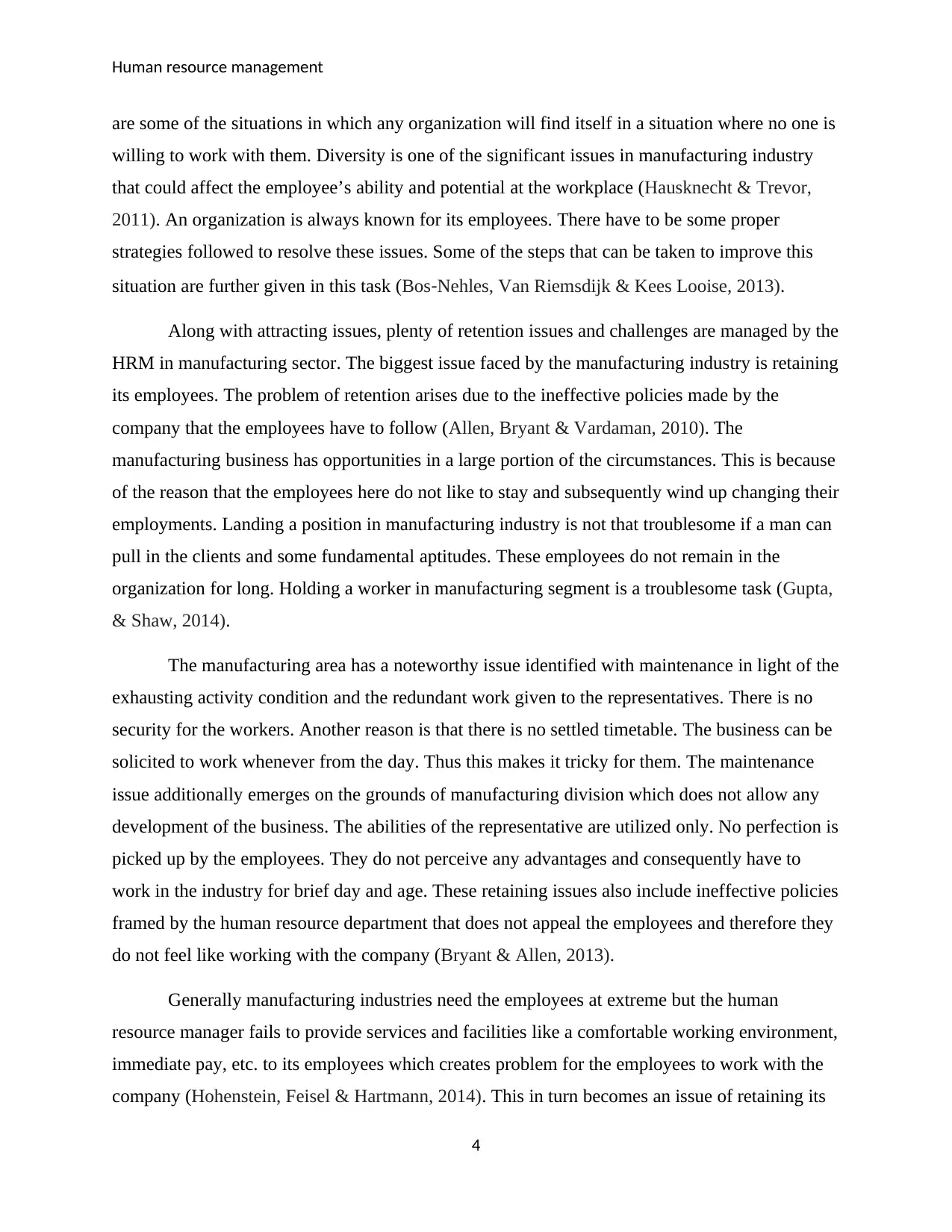
Human resource management
are some of the situations in which any organization will find itself in a situation where no one is
willing to work with them. Diversity is one of the significant issues in manufacturing industry
that could affect the employee’s ability and potential at the workplace (Hausknecht & Trevor,
2011). An organization is always known for its employees. There have to be some proper
strategies followed to resolve these issues. Some of the steps that can be taken to improve this
situation are further given in this task (Bos‐Nehles, Van Riemsdijk & Kees Looise, 2013).
Along with attracting issues, plenty of retention issues and challenges are managed by the
HRM in manufacturing sector. The biggest issue faced by the manufacturing industry is retaining
its employees. The problem of retention arises due to the ineffective policies made by the
company that the employees have to follow (Allen, Bryant & Vardaman, 2010). The
manufacturing business has opportunities in a large portion of the circumstances. This is because
of the reason that the employees here do not like to stay and subsequently wind up changing their
employments. Landing a position in manufacturing industry is not that troublesome if a man can
pull in the clients and some fundamental aptitudes. These employees do not remain in the
organization for long. Holding a worker in manufacturing segment is a troublesome task (Gupta,
& Shaw, 2014).
The manufacturing area has a noteworthy issue identified with maintenance in light of the
exhausting activity condition and the redundant work given to the representatives. There is no
security for the workers. Another reason is that there is no settled timetable. The business can be
solicited to work whenever from the day. Thus this makes it tricky for them. The maintenance
issue additionally emerges on the grounds of manufacturing division which does not allow any
development of the business. The abilities of the representative are utilized only. No perfection is
picked up by the employees. They do not perceive any advantages and consequently have to
work in the industry for brief day and age. These retaining issues also include ineffective policies
framed by the human resource department that does not appeal the employees and therefore they
do not feel like working with the company (Bryant & Allen, 2013).
Generally manufacturing industries need the employees at extreme but the human
resource manager fails to provide services and facilities like a comfortable working environment,
immediate pay, etc. to its employees which creates problem for the employees to work with the
company (Hohenstein, Feisel & Hartmann, 2014). This in turn becomes an issue of retaining its
4
are some of the situations in which any organization will find itself in a situation where no one is
willing to work with them. Diversity is one of the significant issues in manufacturing industry
that could affect the employee’s ability and potential at the workplace (Hausknecht & Trevor,
2011). An organization is always known for its employees. There have to be some proper
strategies followed to resolve these issues. Some of the steps that can be taken to improve this
situation are further given in this task (Bos‐Nehles, Van Riemsdijk & Kees Looise, 2013).
Along with attracting issues, plenty of retention issues and challenges are managed by the
HRM in manufacturing sector. The biggest issue faced by the manufacturing industry is retaining
its employees. The problem of retention arises due to the ineffective policies made by the
company that the employees have to follow (Allen, Bryant & Vardaman, 2010). The
manufacturing business has opportunities in a large portion of the circumstances. This is because
of the reason that the employees here do not like to stay and subsequently wind up changing their
employments. Landing a position in manufacturing industry is not that troublesome if a man can
pull in the clients and some fundamental aptitudes. These employees do not remain in the
organization for long. Holding a worker in manufacturing segment is a troublesome task (Gupta,
& Shaw, 2014).
The manufacturing area has a noteworthy issue identified with maintenance in light of the
exhausting activity condition and the redundant work given to the representatives. There is no
security for the workers. Another reason is that there is no settled timetable. The business can be
solicited to work whenever from the day. Thus this makes it tricky for them. The maintenance
issue additionally emerges on the grounds of manufacturing division which does not allow any
development of the business. The abilities of the representative are utilized only. No perfection is
picked up by the employees. They do not perceive any advantages and consequently have to
work in the industry for brief day and age. These retaining issues also include ineffective policies
framed by the human resource department that does not appeal the employees and therefore they
do not feel like working with the company (Bryant & Allen, 2013).
Generally manufacturing industries need the employees at extreme but the human
resource manager fails to provide services and facilities like a comfortable working environment,
immediate pay, etc. to its employees which creates problem for the employees to work with the
company (Hohenstein, Feisel & Hartmann, 2014). This in turn becomes an issue of retaining its
4
Paraphrase This Document
Need a fresh take? Get an instant paraphrase of this document with our AI Paraphraser
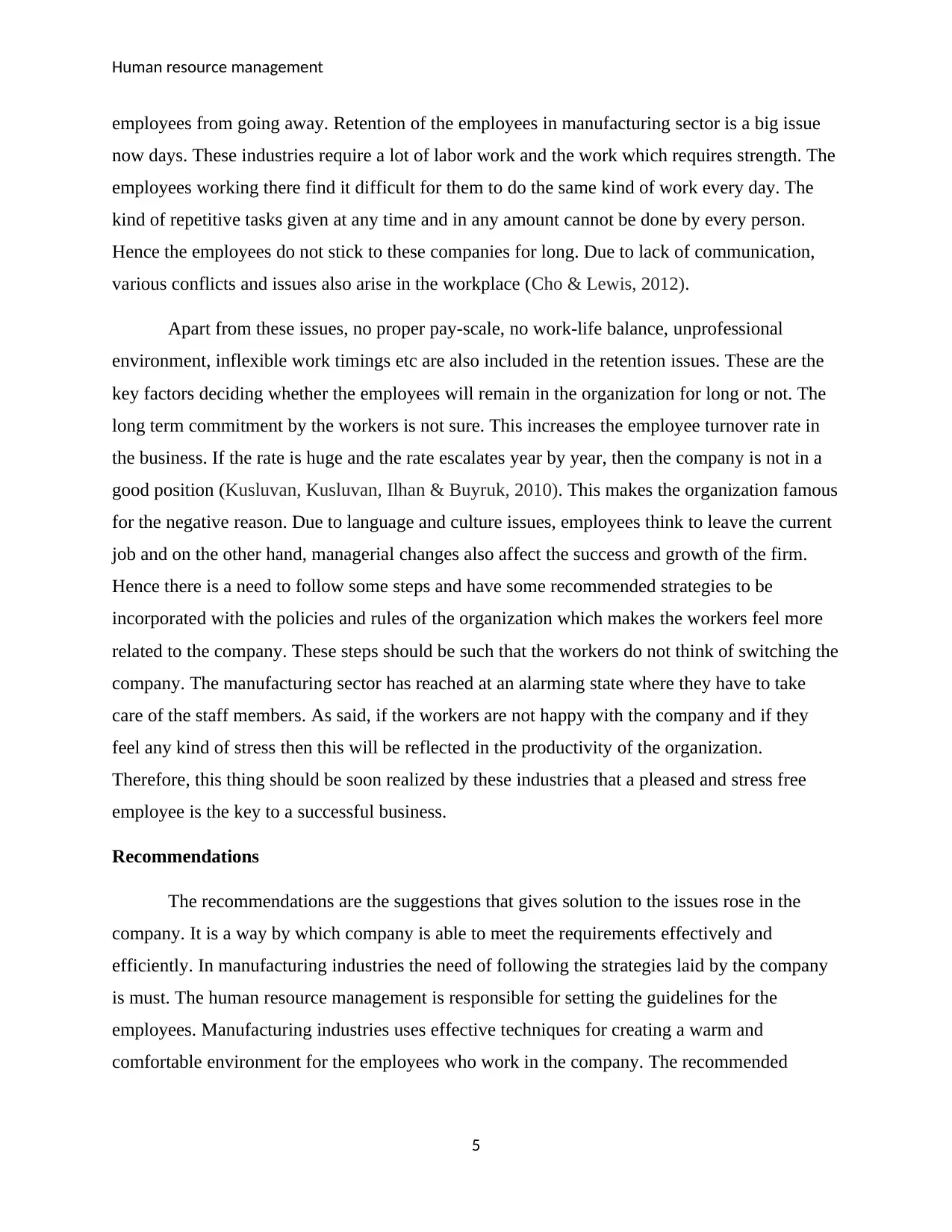
Human resource management
employees from going away. Retention of the employees in manufacturing sector is a big issue
now days. These industries require a lot of labor work and the work which requires strength. The
employees working there find it difficult for them to do the same kind of work every day. The
kind of repetitive tasks given at any time and in any amount cannot be done by every person.
Hence the employees do not stick to these companies for long. Due to lack of communication,
various conflicts and issues also arise in the workplace (Cho & Lewis, 2012).
Apart from these issues, no proper pay-scale, no work-life balance, unprofessional
environment, inflexible work timings etc are also included in the retention issues. These are the
key factors deciding whether the employees will remain in the organization for long or not. The
long term commitment by the workers is not sure. This increases the employee turnover rate in
the business. If the rate is huge and the rate escalates year by year, then the company is not in a
good position (Kusluvan, Kusluvan, Ilhan & Buyruk, 2010). This makes the organization famous
for the negative reason. Due to language and culture issues, employees think to leave the current
job and on the other hand, managerial changes also affect the success and growth of the firm.
Hence there is a need to follow some steps and have some recommended strategies to be
incorporated with the policies and rules of the organization which makes the workers feel more
related to the company. These steps should be such that the workers do not think of switching the
company. The manufacturing sector has reached at an alarming state where they have to take
care of the staff members. As said, if the workers are not happy with the company and if they
feel any kind of stress then this will be reflected in the productivity of the organization.
Therefore, this thing should be soon realized by these industries that a pleased and stress free
employee is the key to a successful business.
Recommendations
The recommendations are the suggestions that gives solution to the issues rose in the
company. It is a way by which company is able to meet the requirements effectively and
efficiently. In manufacturing industries the need of following the strategies laid by the company
is must. The human resource management is responsible for setting the guidelines for the
employees. Manufacturing industries uses effective techniques for creating a warm and
comfortable environment for the employees who work in the company. The recommended
5
employees from going away. Retention of the employees in manufacturing sector is a big issue
now days. These industries require a lot of labor work and the work which requires strength. The
employees working there find it difficult for them to do the same kind of work every day. The
kind of repetitive tasks given at any time and in any amount cannot be done by every person.
Hence the employees do not stick to these companies for long. Due to lack of communication,
various conflicts and issues also arise in the workplace (Cho & Lewis, 2012).
Apart from these issues, no proper pay-scale, no work-life balance, unprofessional
environment, inflexible work timings etc are also included in the retention issues. These are the
key factors deciding whether the employees will remain in the organization for long or not. The
long term commitment by the workers is not sure. This increases the employee turnover rate in
the business. If the rate is huge and the rate escalates year by year, then the company is not in a
good position (Kusluvan, Kusluvan, Ilhan & Buyruk, 2010). This makes the organization famous
for the negative reason. Due to language and culture issues, employees think to leave the current
job and on the other hand, managerial changes also affect the success and growth of the firm.
Hence there is a need to follow some steps and have some recommended strategies to be
incorporated with the policies and rules of the organization which makes the workers feel more
related to the company. These steps should be such that the workers do not think of switching the
company. The manufacturing sector has reached at an alarming state where they have to take
care of the staff members. As said, if the workers are not happy with the company and if they
feel any kind of stress then this will be reflected in the productivity of the organization.
Therefore, this thing should be soon realized by these industries that a pleased and stress free
employee is the key to a successful business.
Recommendations
The recommendations are the suggestions that gives solution to the issues rose in the
company. It is a way by which company is able to meet the requirements effectively and
efficiently. In manufacturing industries the need of following the strategies laid by the company
is must. The human resource management is responsible for setting the guidelines for the
employees. Manufacturing industries uses effective techniques for creating a warm and
comfortable environment for the employees who work in the company. The recommended
5

Human resource management
suggestions for the major issues seen in the business include:
The human resource department can make better policies and norms and ask the
employees to follow them in a proper order (Festing & Eidems, 2011). This will create a
disciplinary environment in the business. Human resource will therefore be able to manage the
relationships between the employees and this will reduce the chances of conflicts in the firm. The
problem that is generally seen in the manufacturing industries include proper managing of
keeping the track record about the amount of goods been produced and sold by the organization.
The human resource managers are also responsible for guiding the employees so that they can
work with a positive approach. In order to guide them, the organization can motivate them by
holding meetings and conferences. This can be a beneficial aspect for the business. Holding
regular meetings and conferences will make the employees get close to the company and know
what causes the manufacturing industries achieve the desired goals and also make the employees
understand how much it is important for them to work with maximum efforts (Moideenkutty, Al-
Lamki & Sree Rama Murthy, 2011).
To carry the healthy and peaceful environment further it is recommended that human
resource management must observe the activities of the workers and appreciate them for their
efforts. This encourages them and makes them work on the tasks willingly. The human resource
manager can give incentives and bonuses in the form of appreciating employees for the amount
of energy they put to get the task done effectively (Sekhar, Patwardhan & Singh, 2013). In the
manufacturing industry, the employees are mainly responsible for the task of maintaining the
manufacturing of goods and services from one place to another. They can follow a proper and
innovative method of recruiting and selecting employees who are a talented and can maintain a
positive attitude at the workplace. This can be done by promoting the industry in the colleges and
universities where they have the chances of getting required employees. The salary given to
employees must be such that it can satisfy the employees and can make them interested in
working for the firm. The ability of the employee must be highlighted in front whole
organization. This can enable other employees to give their best in the assigned task to get the
appreciation (Jiang, Lepak, Han, Hong, Kim & Winkler, 2012).
6
suggestions for the major issues seen in the business include:
The human resource department can make better policies and norms and ask the
employees to follow them in a proper order (Festing & Eidems, 2011). This will create a
disciplinary environment in the business. Human resource will therefore be able to manage the
relationships between the employees and this will reduce the chances of conflicts in the firm. The
problem that is generally seen in the manufacturing industries include proper managing of
keeping the track record about the amount of goods been produced and sold by the organization.
The human resource managers are also responsible for guiding the employees so that they can
work with a positive approach. In order to guide them, the organization can motivate them by
holding meetings and conferences. This can be a beneficial aspect for the business. Holding
regular meetings and conferences will make the employees get close to the company and know
what causes the manufacturing industries achieve the desired goals and also make the employees
understand how much it is important for them to work with maximum efforts (Moideenkutty, Al-
Lamki & Sree Rama Murthy, 2011).
To carry the healthy and peaceful environment further it is recommended that human
resource management must observe the activities of the workers and appreciate them for their
efforts. This encourages them and makes them work on the tasks willingly. The human resource
manager can give incentives and bonuses in the form of appreciating employees for the amount
of energy they put to get the task done effectively (Sekhar, Patwardhan & Singh, 2013). In the
manufacturing industry, the employees are mainly responsible for the task of maintaining the
manufacturing of goods and services from one place to another. They can follow a proper and
innovative method of recruiting and selecting employees who are a talented and can maintain a
positive attitude at the workplace. This can be done by promoting the industry in the colleges and
universities where they have the chances of getting required employees. The salary given to
employees must be such that it can satisfy the employees and can make them interested in
working for the firm. The ability of the employee must be highlighted in front whole
organization. This can enable other employees to give their best in the assigned task to get the
appreciation (Jiang, Lepak, Han, Hong, Kim & Winkler, 2012).
6
⊘ This is a preview!⊘
Do you want full access?
Subscribe today to unlock all pages.

Trusted by 1+ million students worldwide

Human resource management
The human resource managers must be aware about the health of the employees. This
helps the company to know about the inability of an employee to work in future and therefore
they can maintain the process of assigning tasks by hiring other employees in advance. This
keeps on continuing the operation of the business. In this way, HRM should provide healthy and
safe working environment to inspire the employees for performing roles effectively. The human
resource department must make sure what goes in the minds of their employees and what causes
trouble in profit making of the business. They must know what the employees expect from the
company in return. The human resource managers then must fulfill their needs and what these
employees expect from its manager (Kaufman, 2015).
It is recommended that the human resource department of the manufacturing industry
must take feedbacks from the customers so that they can get to know about quality of product
supplied in the market and therefore can bring further changes in the product , if any. The
manager of human resource can create an open communication among the employees. This can
initiate them to come in front and become extrovert by telling about themselves to the company.
The purpose of this strategy can initiate a comfortable environment with the coming of fresher. It
is recommended by the company to its HR department that they must assign a leader to each task
that works in groups. Leadership style helps the employees to get their problems solved in less
time by discussing it directly from the leaders irrespective of going to the authorities indirectly.
Hence, following these recommendations can become a benefit for the manufacturing industry. It
can also manage the issues faced by human resource in attracting and retaining employees at the
workplace (Nanjundeswaraswamy & Swamy, 2012).
Conclusion
The above report highlights that without the support of employees the company cannot
run and earn its target. It is important for them to solve the issues caused in attracting the
employees as well as retaining them from going away at the workplace. The recommendations
provided by the employees is a kind of help given to the manufacturing industry to maintain
harmony in the environment. The main focus of the report is to highlight the key challenges that
human resource manager has to face in managing the growth of the business by continuing the
interest of the employees. The manufacturing industry has seen that the workers get effectively
baffled and that influence them to consider exchanging or leaving that association. The paper
7
The human resource managers must be aware about the health of the employees. This
helps the company to know about the inability of an employee to work in future and therefore
they can maintain the process of assigning tasks by hiring other employees in advance. This
keeps on continuing the operation of the business. In this way, HRM should provide healthy and
safe working environment to inspire the employees for performing roles effectively. The human
resource department must make sure what goes in the minds of their employees and what causes
trouble in profit making of the business. They must know what the employees expect from the
company in return. The human resource managers then must fulfill their needs and what these
employees expect from its manager (Kaufman, 2015).
It is recommended that the human resource department of the manufacturing industry
must take feedbacks from the customers so that they can get to know about quality of product
supplied in the market and therefore can bring further changes in the product , if any. The
manager of human resource can create an open communication among the employees. This can
initiate them to come in front and become extrovert by telling about themselves to the company.
The purpose of this strategy can initiate a comfortable environment with the coming of fresher. It
is recommended by the company to its HR department that they must assign a leader to each task
that works in groups. Leadership style helps the employees to get their problems solved in less
time by discussing it directly from the leaders irrespective of going to the authorities indirectly.
Hence, following these recommendations can become a benefit for the manufacturing industry. It
can also manage the issues faced by human resource in attracting and retaining employees at the
workplace (Nanjundeswaraswamy & Swamy, 2012).
Conclusion
The above report highlights that without the support of employees the company cannot
run and earn its target. It is important for them to solve the issues caused in attracting the
employees as well as retaining them from going away at the workplace. The recommendations
provided by the employees is a kind of help given to the manufacturing industry to maintain
harmony in the environment. The main focus of the report is to highlight the key challenges that
human resource manager has to face in managing the growth of the business by continuing the
interest of the employees. The manufacturing industry has seen that the workers get effectively
baffled and that influence them to consider exchanging or leaving that association. The paper
7
Paraphrase This Document
Need a fresh take? Get an instant paraphrase of this document with our AI Paraphraser
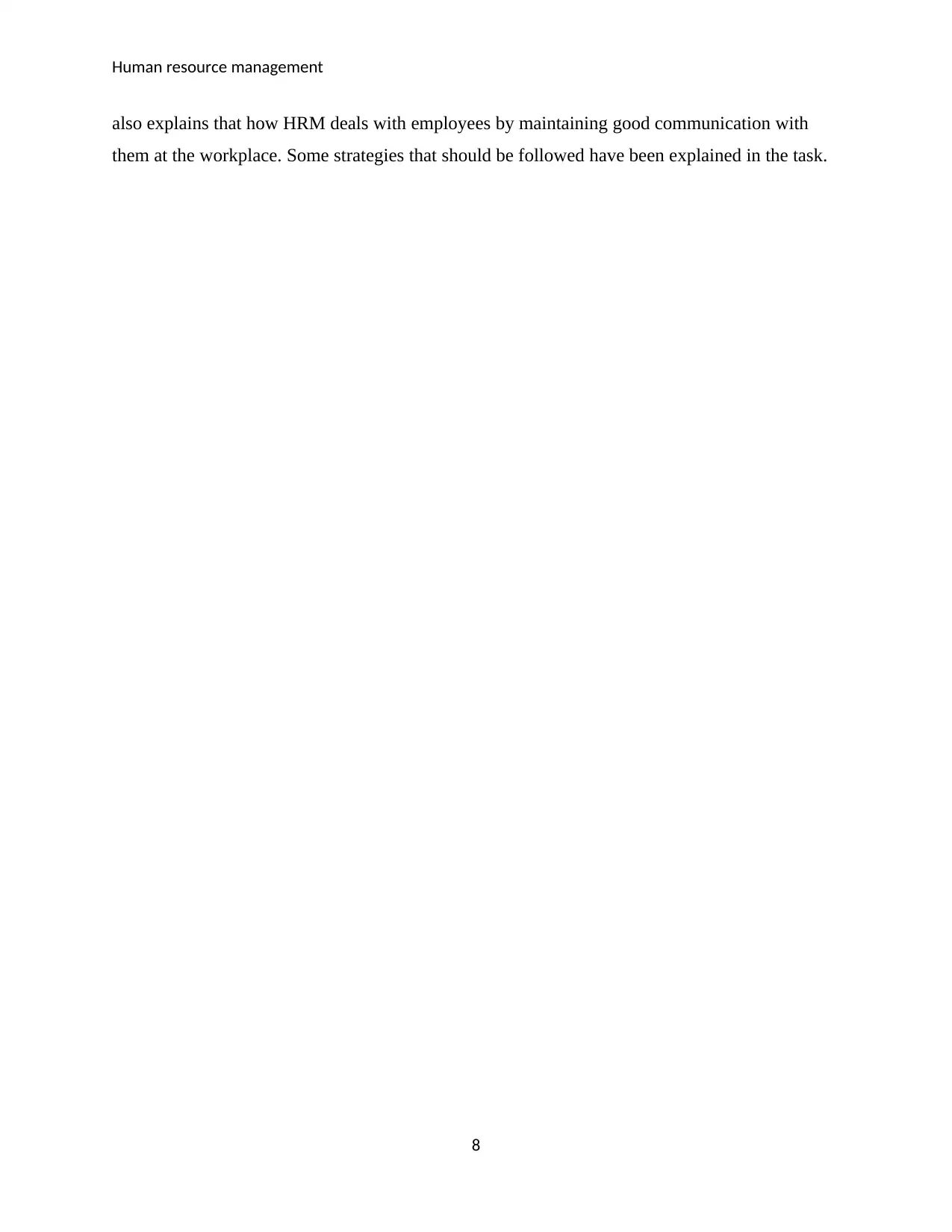
Human resource management
also explains that how HRM deals with employees by maintaining good communication with
them at the workplace. Some strategies that should be followed have been explained in the task.
8
also explains that how HRM deals with employees by maintaining good communication with
them at the workplace. Some strategies that should be followed have been explained in the task.
8
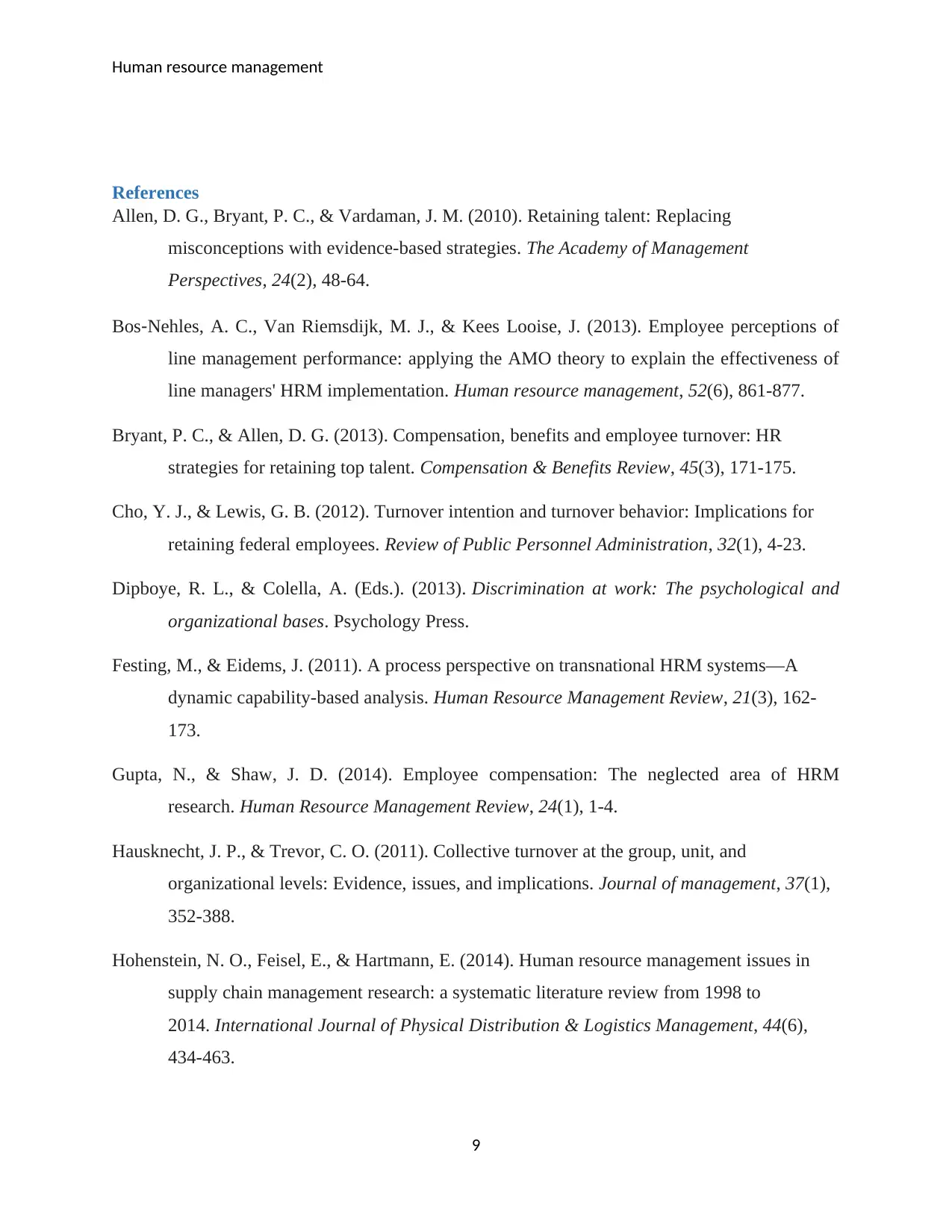
Human resource management
References
Allen, D. G., Bryant, P. C., & Vardaman, J. M. (2010). Retaining talent: Replacing
misconceptions with evidence-based strategies. The Academy of Management
Perspectives, 24(2), 48-64.
Bos‐Nehles, A. C., Van Riemsdijk, M. J., & Kees Looise, J. (2013). Employee perceptions of
line management performance: applying the AMO theory to explain the effectiveness of
line managers' HRM implementation. Human resource management, 52(6), 861-877.
Bryant, P. C., & Allen, D. G. (2013). Compensation, benefits and employee turnover: HR
strategies for retaining top talent. Compensation & Benefits Review, 45(3), 171-175.
Cho, Y. J., & Lewis, G. B. (2012). Turnover intention and turnover behavior: Implications for
retaining federal employees. Review of Public Personnel Administration, 32(1), 4-23.
Dipboye, R. L., & Colella, A. (Eds.). (2013). Discrimination at work: The psychological and
organizational bases. Psychology Press.
Festing, M., & Eidems, J. (2011). A process perspective on transnational HRM systems—A
dynamic capability-based analysis. Human Resource Management Review, 21(3), 162-
173.
Gupta, N., & Shaw, J. D. (2014). Employee compensation: The neglected area of HRM
research. Human Resource Management Review, 24(1), 1-4.
Hausknecht, J. P., & Trevor, C. O. (2011). Collective turnover at the group, unit, and
organizational levels: Evidence, issues, and implications. Journal of management, 37(1),
352-388.
Hohenstein, N. O., Feisel, E., & Hartmann, E. (2014). Human resource management issues in
supply chain management research: a systematic literature review from 1998 to
2014. International Journal of Physical Distribution & Logistics Management, 44(6),
434-463.
9
References
Allen, D. G., Bryant, P. C., & Vardaman, J. M. (2010). Retaining talent: Replacing
misconceptions with evidence-based strategies. The Academy of Management
Perspectives, 24(2), 48-64.
Bos‐Nehles, A. C., Van Riemsdijk, M. J., & Kees Looise, J. (2013). Employee perceptions of
line management performance: applying the AMO theory to explain the effectiveness of
line managers' HRM implementation. Human resource management, 52(6), 861-877.
Bryant, P. C., & Allen, D. G. (2013). Compensation, benefits and employee turnover: HR
strategies for retaining top talent. Compensation & Benefits Review, 45(3), 171-175.
Cho, Y. J., & Lewis, G. B. (2012). Turnover intention and turnover behavior: Implications for
retaining federal employees. Review of Public Personnel Administration, 32(1), 4-23.
Dipboye, R. L., & Colella, A. (Eds.). (2013). Discrimination at work: The psychological and
organizational bases. Psychology Press.
Festing, M., & Eidems, J. (2011). A process perspective on transnational HRM systems—A
dynamic capability-based analysis. Human Resource Management Review, 21(3), 162-
173.
Gupta, N., & Shaw, J. D. (2014). Employee compensation: The neglected area of HRM
research. Human Resource Management Review, 24(1), 1-4.
Hausknecht, J. P., & Trevor, C. O. (2011). Collective turnover at the group, unit, and
organizational levels: Evidence, issues, and implications. Journal of management, 37(1),
352-388.
Hohenstein, N. O., Feisel, E., & Hartmann, E. (2014). Human resource management issues in
supply chain management research: a systematic literature review from 1998 to
2014. International Journal of Physical Distribution & Logistics Management, 44(6),
434-463.
9
⊘ This is a preview!⊘
Do you want full access?
Subscribe today to unlock all pages.

Trusted by 1+ million students worldwide
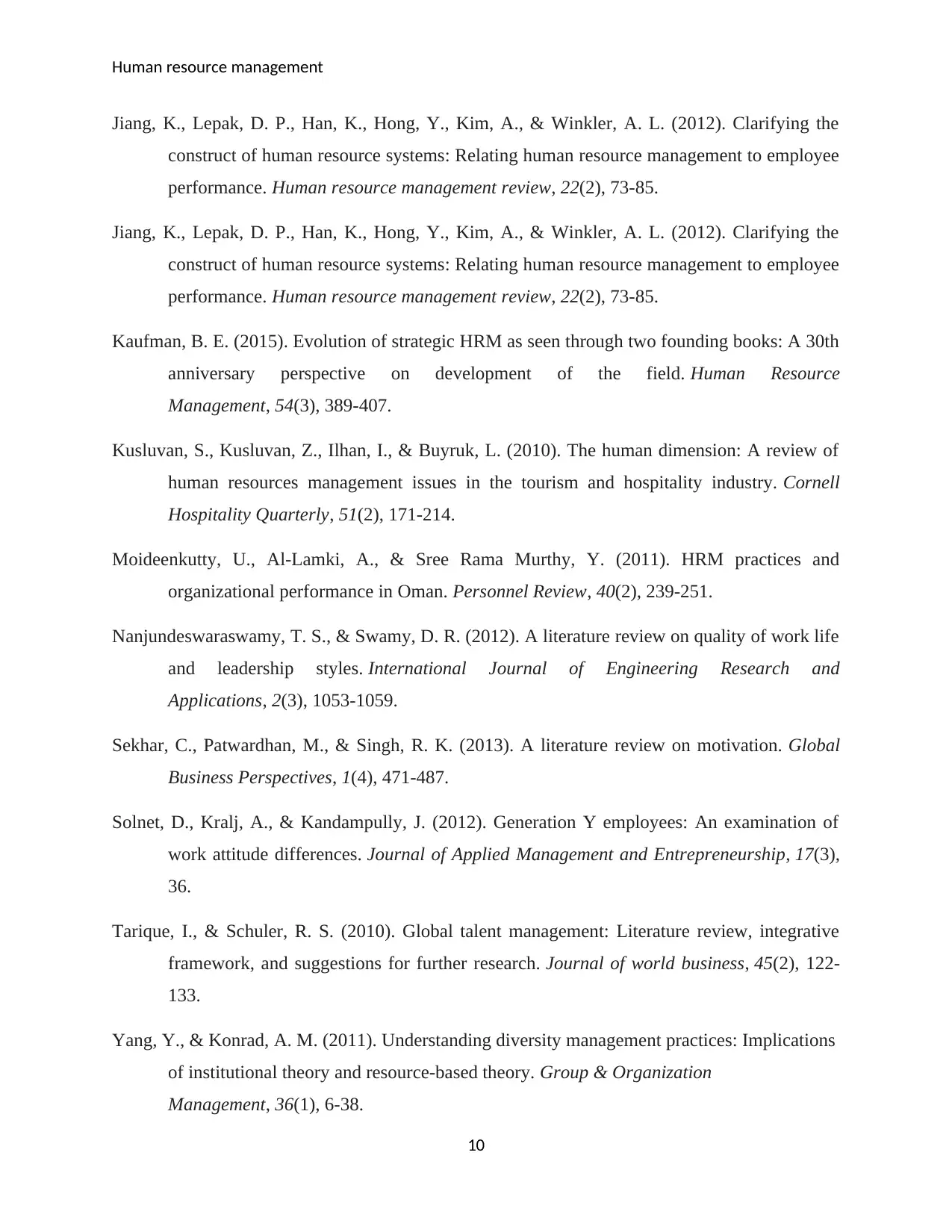
Human resource management
Jiang, K., Lepak, D. P., Han, K., Hong, Y., Kim, A., & Winkler, A. L. (2012). Clarifying the
construct of human resource systems: Relating human resource management to employee
performance. Human resource management review, 22(2), 73-85.
Jiang, K., Lepak, D. P., Han, K., Hong, Y., Kim, A., & Winkler, A. L. (2012). Clarifying the
construct of human resource systems: Relating human resource management to employee
performance. Human resource management review, 22(2), 73-85.
Kaufman, B. E. (2015). Evolution of strategic HRM as seen through two founding books: A 30th
anniversary perspective on development of the field. Human Resource
Management, 54(3), 389-407.
Kusluvan, S., Kusluvan, Z., Ilhan, I., & Buyruk, L. (2010). The human dimension: A review of
human resources management issues in the tourism and hospitality industry. Cornell
Hospitality Quarterly, 51(2), 171-214.
Moideenkutty, U., Al-Lamki, A., & Sree Rama Murthy, Y. (2011). HRM practices and
organizational performance in Oman. Personnel Review, 40(2), 239-251.
Nanjundeswaraswamy, T. S., & Swamy, D. R. (2012). A literature review on quality of work life
and leadership styles. International Journal of Engineering Research and
Applications, 2(3), 1053-1059.
Sekhar, C., Patwardhan, M., & Singh, R. K. (2013). A literature review on motivation. Global
Business Perspectives, 1(4), 471-487.
Solnet, D., Kralj, A., & Kandampully, J. (2012). Generation Y employees: An examination of
work attitude differences. Journal of Applied Management and Entrepreneurship, 17(3),
36.
Tarique, I., & Schuler, R. S. (2010). Global talent management: Literature review, integrative
framework, and suggestions for further research. Journal of world business, 45(2), 122-
133.
Yang, Y., & Konrad, A. M. (2011). Understanding diversity management practices: Implications
of institutional theory and resource-based theory. Group & Organization
Management, 36(1), 6-38.
10
Jiang, K., Lepak, D. P., Han, K., Hong, Y., Kim, A., & Winkler, A. L. (2012). Clarifying the
construct of human resource systems: Relating human resource management to employee
performance. Human resource management review, 22(2), 73-85.
Jiang, K., Lepak, D. P., Han, K., Hong, Y., Kim, A., & Winkler, A. L. (2012). Clarifying the
construct of human resource systems: Relating human resource management to employee
performance. Human resource management review, 22(2), 73-85.
Kaufman, B. E. (2015). Evolution of strategic HRM as seen through two founding books: A 30th
anniversary perspective on development of the field. Human Resource
Management, 54(3), 389-407.
Kusluvan, S., Kusluvan, Z., Ilhan, I., & Buyruk, L. (2010). The human dimension: A review of
human resources management issues in the tourism and hospitality industry. Cornell
Hospitality Quarterly, 51(2), 171-214.
Moideenkutty, U., Al-Lamki, A., & Sree Rama Murthy, Y. (2011). HRM practices and
organizational performance in Oman. Personnel Review, 40(2), 239-251.
Nanjundeswaraswamy, T. S., & Swamy, D. R. (2012). A literature review on quality of work life
and leadership styles. International Journal of Engineering Research and
Applications, 2(3), 1053-1059.
Sekhar, C., Patwardhan, M., & Singh, R. K. (2013). A literature review on motivation. Global
Business Perspectives, 1(4), 471-487.
Solnet, D., Kralj, A., & Kandampully, J. (2012). Generation Y employees: An examination of
work attitude differences. Journal of Applied Management and Entrepreneurship, 17(3),
36.
Tarique, I., & Schuler, R. S. (2010). Global talent management: Literature review, integrative
framework, and suggestions for further research. Journal of world business, 45(2), 122-
133.
Yang, Y., & Konrad, A. M. (2011). Understanding diversity management practices: Implications
of institutional theory and resource-based theory. Group & Organization
Management, 36(1), 6-38.
10
Paraphrase This Document
Need a fresh take? Get an instant paraphrase of this document with our AI Paraphraser
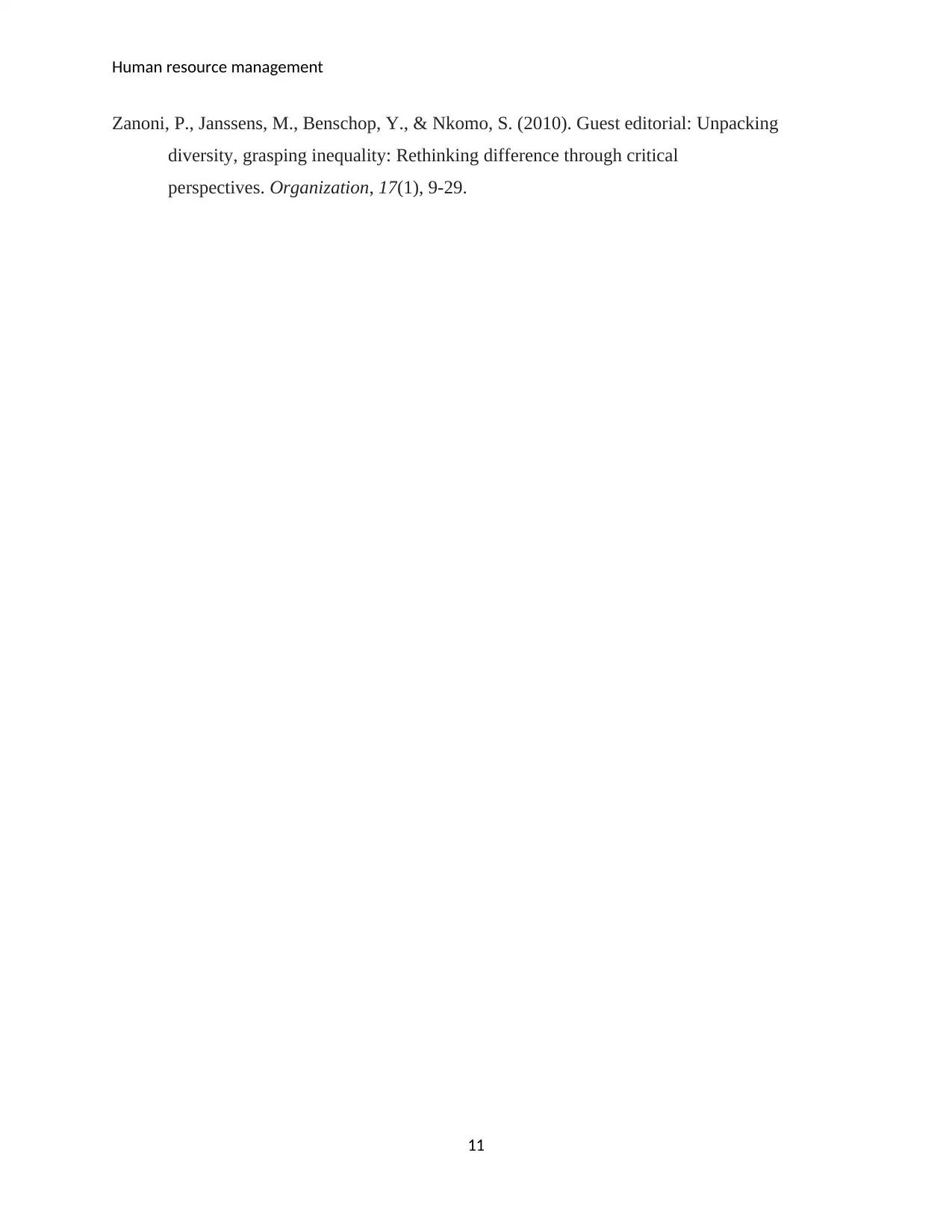
Human resource management
Zanoni, P., Janssens, M., Benschop, Y., & Nkomo, S. (2010). Guest editorial: Unpacking
diversity, grasping inequality: Rethinking difference through critical
perspectives. Organization, 17(1), 9-29.
11
Zanoni, P., Janssens, M., Benschop, Y., & Nkomo, S. (2010). Guest editorial: Unpacking
diversity, grasping inequality: Rethinking difference through critical
perspectives. Organization, 17(1), 9-29.
11
1 out of 11
Related Documents
Your All-in-One AI-Powered Toolkit for Academic Success.
+13062052269
info@desklib.com
Available 24*7 on WhatsApp / Email
![[object Object]](/_next/static/media/star-bottom.7253800d.svg)
Unlock your academic potential
Copyright © 2020–2025 A2Z Services. All Rights Reserved. Developed and managed by ZUCOL.




